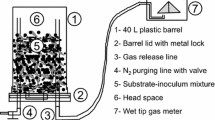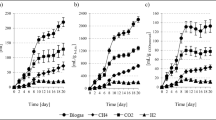Abstract
We examined hydrogen production from a dairy cow waste slurry (13.4 g of volatile solids per liter) by batch cultures in a temperature range from 37 to 85°C, using microflora naturally present within the slurry. Without the addition of seed bacteria, hydrogen was produced by simply incubating the slurry, using the microflora within the slurry. Interestingly, two peaks of fermentation temperatures for hydrogen production from the slurry were observed at 60 and 75°C (392 and 248 ml H2 per liter of slurry, respectively). After the termination of the hydrogen evolution, the microflora cultured at 60°C displayed hydrogen-consuming activity, but hydrogen-consuming activity of the microflora cultured at 75°C was not detected, at least for 24 days. At both 60 and 75°C, the main by-product was acetate, and the optimum pH of the slurry for hydrogen production was around neutral. Bacteria related to hydrogen-producing moderate and extreme thermophiles, Clostridium thermocellum and Caldanaerobacter subterraneus, were detected in the slurries cultured at 60 and 75°C, respectively, by denaturing gradient gel electrophoresis analyses, using the V3 region of 16S rDNA.






Similar content being viewed by others
References
Atif AAY, Fakhru’l-Razi A, Ngan MA, Morimoto M, Iyuke SE, Veziroglu NT (2005) Fed batch production of hydrogen from palm oil mill effluent using anaerobic microflora. Int J Hydrogen Energy 30:1393–1397
Audiffrin C, Cayol JL, Joulian C, Casalot L, Thomas P, Garcia JL, Ollivier B (2003) Desulfonauticus submarinus gen. nov., sp nov., a novel sulfate-reducing bacterium isolated from a deep-sea hydrothermal vent. Int J Syst Evol Microbiol 53:1585–1590
Chamkha M, Patel BKC, Garcia JL, Labat M (2001) Isolation of Clostridium bifermentans from oil mill wastewaters converting cinnamic 3-phenylpropionic acid and emendation of the species. Anaerobe 7:189–197
Chen CC, Lin CY, Lin MC (2002) Acid–base enrichment enhances anaerobic hydrogen production process. Appl Microbiol Biotechnol 58:224–228
Fardeau ML, Magot M, Patel BK, Thomas P, Garcia JL, Ollivier B (2000) Thermoanaerobacter subterraneus sp. nov., a novel thermophile isolated from oilfield water. Int J Syst Evol Microbiol 50:2141–2149
Fardeau ML, Bonilla Salinas M, L’Haridon S, Jeanthon C, Verhe F, Cayol JL, Patel BK, Garcia JL, Ollivier B (2004) Isolation from oil reservoirs of novel thermophilic anaerobes phylogenetically related to Thermoanaerobacter subterraneus: reassignment of T. subterraneus, Thermoanaerobacter yonseiensis, Thermoanaerobacter tengcongensis and Carboxydibrachium pacificum to Caldanaerobacter subterraneus gen. nov., sp. nov., comb. nov. as four novel subspecies. Int J Syst Evol Microbiol 54:467–474
Gill SR, Pop M, DeBoy RT, Eckburg PB, Turnbaugh PJ, Samuel BS, Gordon JI, Relman DA, Fraser-Liggett CM, Nelson KE (2006) Metagenomic analysis of the human distal gut microbiome. Science 312:1355–1359
Han SK, Shin HS (2004) Performance of an innovative two-stage process converting food waste to hydrogen and methane. J Air Waste Manage Assoc 54:242–249
Han SK, Kim SH, Kim HW, Shin HS (2005) Pilot-scale two-stage process: a combination of acidogenic hydrogenesis and methanogenesis. Water Sci Technol 52:131–138
Hawkes FR, Dinsdale R, Hawkes DL, Hussy I (2002) Sustainable fermentative hydrogen production: challenges for process optimisation. Int J Hydrogen Energy 27:1339–1347
Heyndrickx M, Devos P, Speybrouck A, Deley J (1989) Fermentation of mannitol by Clostridium butyricum: role of acetate as an external hydrogen acceptor. Appl Microbiol Biotechnol 31:323–328
Hussy I, Hawkes FR, Dinsdale R, Hawkes DL (2003) Continuous fermentative hydrogen production from a wheat starch co-product by mixed microflora. Biotechnol Bioeng 84:619–626
Hussy I, Hawkes FR, Dinsdale R, Hawkes DL (2005) Continuous fermentative hydrogen production from sucrose and sugarbeet. Int J Hydrogen Energy 30:471–483
Hyun HH, Zeikus JG, Longin R, Millet J, Ryter A (1983) Ultrastructure and extreme heat resistance of spores from thermophilic Clostridium species. J Bacteriol 156:1332–1337
Jung G, Ferard G (1978) Enzyme-coupled measurement of ethanol in whole-blood and plasma with a centrifugal analyzer. Clin Chem 24:873–876
Karube I, Matsunaga T, Tsuru S, Suzuki S (1976) Continuous hydrogen production by immobilized whole cells of Clostridium butyricum. Biochim Biophys Acta 444:338–343
Kim BC, Grote R, Lee DW, Antranikian G, Pyun YR (2001) Thermoanaerobacter yonseiensis sp. nov., a novel extremely thermophilic, xylose-utilizing bacterium that grows at up to 85 degrees C. Int J Syst Evol Microbiol 51:1539–1548
Kotsopoulos TA, Zeng RJ, Angelidaki I (2006) Biohydrogen production in granular up-flow anaerobic sludge blanket (UASB) reactors with mixed cultures under hyper-thermophilic temperature (70 degrees C). Biotechnol Bioeng 94:296–302
Kraemer JT, Bagley DM (2005) Continuous fermentative hydrogen production using a two-phase reactor system with recycle. Environ Sci Technol 39:3819–3825
Lamed RJ, Lobos JH, Su TM (1988) Effects of Stirring and Hydrogen on Fermentation Products of Clostridium thermocellum. Appl Environ Microbiol 54:1216–1221
Lay JJ, Lee YJ, Noike T (1999) Feasibility of biological hydrogen production from organic fraction of municipal solid waste. Water Res 33:2579–2586
Lay JJ, Tsai CJ, Huang CC, Chang JJ, Chou CH, Fan KS, Chang JI, Hsu PC (2005) Influences of pH and hydraulic retention time on anaerobes converting beer processing wastes into hydrogen. Water Sci Technol 52:123–129
Lin CY, Chang RC (1999) Hydrogen production during the anaerobic acidogenic conversion of glucose. J Chem Technol Biotechnol 74:498–500
Liu H, Fang HHP (2003) Hydrogen production from wastewater by acidogenic granular sludge. Water Sci Technol 47:153–158
Madden RH (1983) Isolation and characterization of Clostridium stercorarium sp-nov, cellulolytic thermophile. Int J Syst Bacteriol 33:837–840
Mizuno O, Ohara T, Shinya M, Noike T (2000) Characteristics of hydrogen production from bean curd manufacturing waste by anaerobic microflora. Water Sci Technol 42:345–350
Mladenovska Z, Mathrani IM, Ahring BK (1995) Isolation and characterization of Caldicellulosiruptor lactoaceticus sp-nov, an extremely thermophilic, cellulolytic, anaerobic bacterium. Arch Microbiol 163:223–230
Monmoto M, Atsuka M, Atif AAY, Ngan MA, Fakhru’l-Razi A, Iyuke SE, Bakir AM (2004) Biological production of hydrogen from glucose by natural anaerobic microflora. Int J Hydrogen Energy 29:709–713
Muyzer G, de Waal EC, Uitterlinden AG (1993) Profiling of complex microbial populations by denaturing gradient gel electrophoresis analysis of polymerase chain reaction-amplified genes coding for 16S rRNA. Appl Environ Microbiol 59:695–700
Nandi R, Sengupta S (1998) Microbial production of hydrogen: An overview. Crit Rev Microbiol 24:61–84
Nielsen AT, Amandusson H, Bjorklund R, Dannetun H, Ejlertsson J, Ekedahl LG, Lundstrom I, Svensson BH (2001) Hydrogen production from organic waste. Int J Hydrogen Energy 26:547–550
Nishio N, Nakashimada Y (2004) High rate production of hydrogen/methane from various substrates and wastes. Adv Biochem Eng Biotechnol 90:63–87
Noike T, Mizuno O (2000) Hydrogen fermentation of organic municipal wastes. Water Sci Technol 42:155–162
Okamoto M, Miyahara T, Mizuno O, Noike T (2000) Biological hydrogen potential of materials characteristic of the organic fraction of municipal solid wastes. Water Sci Technol 41:25–32
Ozutsumi Y, Hayashi H, Sakamoto M, Itabashi H, Benno Y (2005) Culture-independent analysis of fecal microbiota in cattle. Biosci Biotechnol Biochem 69:1793–1797
Rachman MA, Furutani Y, Nakashimada Y, Kakizono T, Nishio N (1997) Enhanced hydrogen production in altered mixed acid fermentation of glucose by Enterobacter aerogenes. J Ferment Bioeng 83:358–363
Roychowdhury S, Cox D, Levandowsky M (1988) Production of hydrogen by microbial fermentation. Int J Hydrogen Energy 13:407–410
Schroder C, Selig M, Schonheit P (1994) Glucose fermentation of acetate, CO2 and H2 in the anaerobic hyperthermophilic eubacterium Thermotoga maritima: involvement of the Embden–Meyerh of pathway. Arch Microbiol 161:460–470
Shin HS, Youn JH, Kim SH (2004) Hydrogen production from food waste in anaerobic mesophilic and thermophilic acidogenesis. Int J Hydrogen Energy 29:1355–1363
Sokolova TG, Gonzalez JM, Kostrikina NA, Chernyh NA, Tourova TP, Kato C, Bonch-Osmolovskaya EA, Robb FT (2001) Carboxydobrachium pacificum gen. nov., sp. nov., a new anaerobic, thermophilic, CO-utilizing marine bacterium from Okinawa Trough. Int J Syst Evol Microbiol 51:141–149
Tajima K, Arai S, Ogata K, Nagamine T, Matsui H, Nakamura M, Aminov RI, Benno Y (2000) Rumen bacterial community transition during adaptation to high-grain diet. Anaerobe 6:273–284
Takaku H, Kodaira S, Kimoto A, Nashimoto M, Takagi M (2006) Microbial communities in the garbage composting with rice hull as an amendment revealed by culture-dependent and -independent approaches. J Biosci Bioeng 101:42–50
Talabardon M, Schwitzguebel JP, Peringer P, Yang ST (2000) Acetic acid production from lactose by an anaerobic thermophilic coculture immobilized in a fibrous-bed bioreactor. Biotechnol Prog 16:1008–1017
Tang YQ, Shigematsu T, Ikbal, Morimura S, Kida K (2004) The effects of micro-aeration on the phylogenetic diversity of microorganisms in a thermophilic anaerobic municipal solid-waste digester. Water Res 38:2537–2550
Tanisho S, Suzuki Y, Wakao N (1987) Fermentative hydrogen evolution by Enterobacter aerogenes strain E. 82005. Int J Hydrogen Energy 12:623–627
Ueno Y, Kawai T, Sato S, Otsuka S, Morimoto M (1995) Biological production of hydrogen from cellulose by natural anaerobic microflora. J Ferment Bioeng 79:395–397
Ueno Y, Otsuka S, Morimoto M (1996) Hydrogen production from industrial wastewater by anaerobic microflora in chemostat culture. J Ferment Bioeng 82:194–197
Ueno Y, Haruta S, Ishii M, Igarashi Y (2001a) Changes in product formation and bacterial community by dilution rate on carbohydrate fermentation by methanogenic microflora in continuous flow stirred tank reactor. Appl Microbiol Biotechnol 57:65–73
Ueno Y, Haruta S, Ishii M, Igarashi Y (2001b) Microbial community in anaerobic hydrogen-producing microflora enriched from sludge compost. Appl Microbiol Biotechnol 57:555–562
Valdez-Vazquez I, Sparling R, Risbey D, Rinderknecht-Seijas N, Poggi-Varaldo HM (2005) Hydrogen generation via anaerobic fermentation of paper mill wastes. Bioresour Technol 96:1907–1913
Wang CC, Chang CW, Chu CP, Lee DJ, Chang BV (2003) Sequential production of hydrogen and methane from wastewater sludge using anaerobic fermentation. J Chin Inst Chem Eng 34:683–687
Xue Y, Xu Y, Liu Y, Ma Y, Zhou P (2001) Thermoanaerobacter tengcongensis sp. nov., a novel anaerobic, saccharolytic, thermophilic bacterium isolated from a hot spring in Tengcong, China. Int J Syst Evol Microbiol 51:1335–1341
Yokoi H, Maki R, Hirose J, Hayashi S (2002) Microbial production of hydrogen from starch-manufacturing wastes. Biomass Bioenergy 22:389–395
Yokoi H, Saitsu A, Uchida H, Hirose J, Hayashi S, Takasaki Y (2001) Microbial hydrogen production from sweet potato starch residue. J Biosci Bioeng 91:58–63
Yu HQ, Zhu ZH, Hu WR, Zhang HS (2002) Hydrogen production from rice winery wastewater in an upflow anaerobic reactor by using mixed anaerobic cultures. Int J Hydrogen Energy 27:1359–1365
Acknowledgements
We are grateful to K. Tajima, Functional Feed Research Team, NILGS, for his critical reading of the manuscript. We also thank H. Kajikawa, K. Sumiya, and the members of the Ruminants and Field Management Section, NILGS, for their helpful assistance and discussions. This work was supported in part by a Grant-in-Aid from the Ministry of Education, Sports, Culture, Science, and Technology, Japan.
Author information
Authors and Affiliations
Corresponding author
Rights and permissions
About this article
Cite this article
Yokoyama, H., Waki, M., Moriya, N. et al. Effect of fermentation temperature on hydrogen production from cow waste slurry by using anaerobic microflora within the slurry. Appl Microbiol Biotechnol 74, 474–483 (2007). https://doi.org/10.1007/s00253-006-0647-4
Received:
Revised:
Accepted:
Published:
Issue Date:
DOI: https://doi.org/10.1007/s00253-006-0647-4




